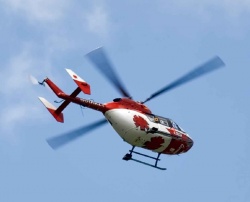Transport of trauma patients by helicopter costly but effective
Johns Hopkins researchers find benefit in air compared with ground transport in certain cases
Seriously injured trauma patients transported to hospitals by helicopter are 16 percent more likely to survive than similarly injured patients brought in by ground ambulance, new Johns Hopkins research shows.


“We know helicopter trips are costly and carry some risks, but this research shows they do save lives,” says study senior author Adil Haider, M.D., M.P.H., an associate professor of surgery, anesthesiology and critical care medicine at the Johns Hopkins University School of Medicine. “It also tells us that we need to sharpen our ability to identify trauma patients who need the helicopter most to ensure that we deploy the helicopter for people who really will benefit from its use.”
Medical evacuation helicopters — iconic symbols of rapid, lifesaving medical transport in the United States — come at a price, both in terms of financial costs and the rare but real risk of potentially tragic crash consequences associated with air flight, according to the study published in the April 18 issue of the Journal of the American Medical Association. A medical helicopter trip costs thousands of dollars, the researchers say, which is charged, in most states, to insurance companies and consumers.
At stake remains the fact that trauma is the leading cause of death and disability among young people around the world, and in the United States, more than 50 million people are injured each year. Some 169,000 die of injury each year, and the most seriously injured, whether victims of car crashes or other causes of injury, are regularly transported to trauma centers near and far by helicopter.
The research team used sophisticated analysis techniques to examine records from more than 223,000 patients 16 years of age and older from the 2007-2009 National Trauma Data Bank. All patients sustained at least moderately severe injuries and were taken to trauma centers. The researchers compared the more than 161,500 patients who were transported by ambulance to the nearly 62,000 who were transported by helicopter. When they adjusted for such factors as injury severity, type of injury and age of the patient, they determined that patients transported to the hospital by air were 16 percent more likely to survive than similarly injured patients transported by ground.
Among their conclusions was that one in 65 significantly injured patients brought to a Level I trauma center by helicopter would die if ground transportation was the only option.
Because no one can yet predict with precision in advance which patients might survive with a flight, transporting all with serious injury might seem warranted, Haider noted. But, he pointed out that in the case of those 65 patients, and using the average cost of helicopter transport in Maryland of $5,000 per patient, where costs are much lower than the average because it has the only state-run helicopter system in the United States, approximately $325,000 would have needed to be spent to transport all of them in order to save one life.
Calling for more research to develop better guidelines to determine “who flies,” Haider sympathizes with paramedics and emergency responders on the scene who make the split-second decisions about whether to call a helicopter in. Sometimes, they make the wrong call, and a patient’s injuries turn out to be less severe than originally believed. But Haider says there is good reason for overuse of the helicopter: the possibility of making the mistake of not calling for a helicopter and watching a patient who might have survived die instead on the way to the hospital.
The advantage of a helicopter flight over an ambulance ride can be both the speed at which the patient gets to the hospital as well as the quality of the emergency medical team aboard the helicopter, which tend to carry the most experienced crews, Haider says.
“In some cases, helicopters don’t help, but just increase the risk because of the flight and add costs,” says Haider, co-director of the Johns Hopkins Center for Surgery Trials and Outcomes Research. “We need a better way to make sure this scarce and valuable resource is used appropriately.”
For more information click here.
###
Other Johns Hopkins researchers involved in the study include Elliott R. Haut, M.D.; S. Nabeel Zafar, M.B.B.S., M.P.H.; Michael G. Millin, M.D., M.P.H.; David T. Efron, M.D.; Susan P. Baker, M.P.H.; Steven M. Bowman, Ph.D.; and Peter J. Pronovost, M.D., Ph.D. Samuel M. Galvagno Jr., D.O., Ph.D., a former Johns Hopkins fellow and faculty member, made major contributions to the research and is its first author.
24.04.2012










